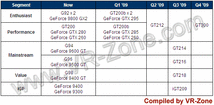Saturday, December 27th 2008

NVIDIA GPU Lineup for 2009 Tabled
The year 2008 has been eventful for the PC graphics industry. This is the year which, for the most of the part, saw some serious competition between NVIDIA and ATI. While pure horsepower and value are what determined product superiority, implementing new technologies is what looks to drive GPU makers in 2009. One of the first of these technologies is the introduction of the 40nm manufacturing process, which facilitates GPU makers to step-up transistor counts or even cut manufacturing costs. VR-Zone, based on a few documents it has access to, compiled a list of GPUs that NVIDIA could pull out of its hat in 2009.
To begin with, NVIDIA is expected to have a full-fledged lineup of GPUs top-to-bottom built on the 40nm fab process within 2009. Before it makes the move to the new fab process, the G200b, built on the 55nm fab process will be given a chance to hold the performance and enthusiast segment offerings by the company, in Q1. Come Q2, and the G200b will be succeeded by GT212. All that while, current G94, G96, G98 will hold the mainstream thru value segments, only to be replaced by GT214, GT216 and GT218 respectively in Q3. NVIDIA's gets a newer IGP too, the iGT209. NVIDIA looks to end the year with a newer high-end GPU, the GT300 to succeed GT212 in Q4.
Source:
VR-Zone
To begin with, NVIDIA is expected to have a full-fledged lineup of GPUs top-to-bottom built on the 40nm fab process within 2009. Before it makes the move to the new fab process, the G200b, built on the 55nm fab process will be given a chance to hold the performance and enthusiast segment offerings by the company, in Q1. Come Q2, and the G200b will be succeeded by GT212. All that while, current G94, G96, G98 will hold the mainstream thru value segments, only to be replaced by GT214, GT216 and GT218 respectively in Q3. NVIDIA's gets a newer IGP too, the iGT209. NVIDIA looks to end the year with a newer high-end GPU, the GT300 to succeed GT212 in Q4.

27 Comments on NVIDIA GPU Lineup for 2009 Tabled
Thank god for EVGA and BFG step ups.
Hmmmm, looks like very short life spans.
GT200a = 1 half
GT200b = 1 quarter
GT21X = 1 half (at least the high end cards, the mainstreams will most likely last longer like the current G92's)
;)
en.wikipedia.org/wiki/Tessellation.
www.control.com/1026202143/index_html
and i expect the gt300 come in q1 2010
And what in the F is a GT212? If it's anything like the previous GT/GTX naming scheme then I don't understand why it's classified in the performance/enthusiast area of this chart.
But this is only a whisper. So i think it's nothing new, but much more horsepower.
Looks like NV is just getting crazy again assigning numbers to cards that have no meaning.
It's been always like that and IMO it just has to do with the number of the project that was chosen to continue into production. Pretty much like with US fighters, the F-22 could have been the F-21 if that was the project that'd won between the two. And maybe I'm mistaken but the F-15 and the F-16 projects started at the same time and F-15 > F-16.In the case of GPU tesselation and the one that Ati has right now is just SUBDIVISION, that is subdivide the polygons into more polygons. It has nothing to do with textures nor with repeating paterns, etc.
It does not really save computing power either, at pure rendering end I mean, because resulting triangles have to be calculated, textured, lit, etc. It does save a lot of memory, something that could make data transfers easier. And it definately makes animation easier: as long as you have enough vertex to make detailed animations, the less vertex the better, so that's something that is potentially keeping game models at "relatively low" poly count. The idea behind using tesselation is to have 20.000-50.000 poly models and make them look as if they had 100.000++ or millions of them. No more spikes in the heads. :)
Tesselation could essentially be used to make models LESS detailed too and get rid of LOD models, something that could be very useful too.
The end goal is to have models that vary on detail depending on the distance or simply the power of the GPU or the settings you use, without the need of LODs and the jumps between them that are so apparent sometimes.
In any case the simple use of tesselation has like a constant performance penalty, much like DX10 has, but more pronounce probably, so the use of it in current games is questionable. See it as phone contracts with a high constant component and a small price per spoken minute. They are not good unless you will speak a lot AND you can pay that much. Current GPUs probably can't "pay" as much still.
EDIT: Oh and on-topic I don't take that chart seriously. That roadmap is VERY different from other expectations/rumors and suggested roadmaps and without any proof to make a decision, which one is to believe...